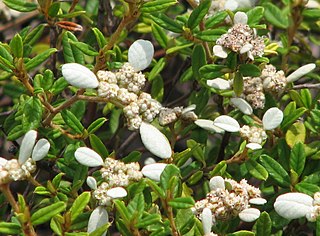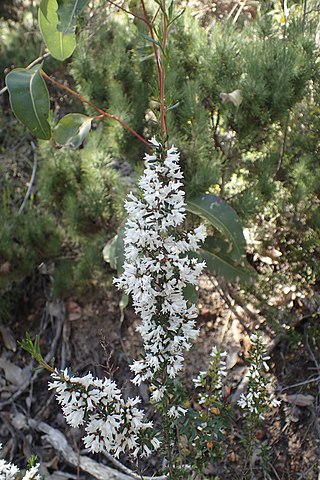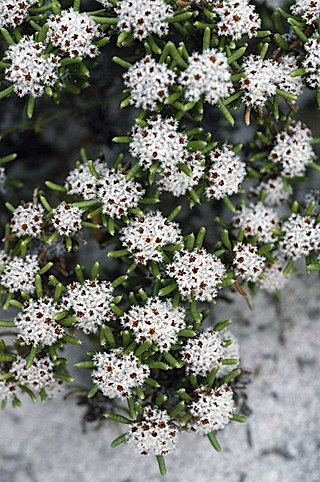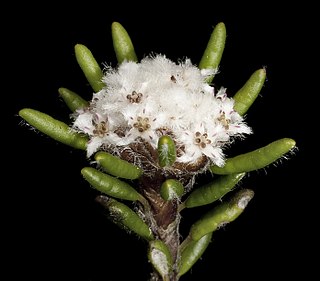
Spyridium globulosum, commonly known as basket bush, is a species of flowering plant in the family Rhamnaceae and is endemic to coastal areas in the south-west of Western Australia. It is a shrub with relatively large leaves and heads of flowers covered with whitish hairs.

Spyridium vexilliferum, commonly known as winged spyridium, or helicopter bush, is a species of flowering plant in the family Rhamnaceae and is endemic to south-eastern Australia. It is a small, low-lying to erect shrub with linear to narrowly elliptic leaves, and dense heads of small white flowers.

Cryptandra arbutiflora, commonly known as waxy cryptandra, is a species of flowering plant in the family Rhamnaceae and is endemic to the southwest of Western Australia. It is a shrub with spiny branches, elliptic to linear leaves and tube-shaped white flowers.

Spyridium burragorang, is a flowering shrub in the family Rhamnaceae. It has dense clusters of whitish flowers at the end of branches, alternate leaves and is endemic to New South Wales.

Spyridium cordatum is a species of flowering plant in the family Rhamnaceae and is endemic to the south-west of Western Australia. It is a prostrate, straggling or ascending shrub with leathery, broadly heart-shaped leaves with a notched tip, 2–4 mm (0.079–0.157 in) long with woolly, white or rust-coloured hairs on the lower side. The heads of flowers are 6.5–8.5 mm (0.26–0.33 in) wide with two to four floral leaves at the base. The sepals are up to 1.6 mm (0.063 in) long the petal tube shaggy-hairy with more or less glabrous lobes.

Spyridium microcephalum is a species of flowering plant in the family Rhamnaceae and is endemic to the south-west of Western Australia. It is a spreading or erect shrub with linear leaves and heads of woolly-hairy flowers.

Spyridium oligocephalum is a species of flowering plant in the family Rhamnaceae and is endemic to the south-west of Western Australia. It is a shrub that typically grows to a height of 0.6–1.5 m, its leaves glabrous except when very young. There are large, papery, orange-brown stipules joined in pairs at their bases, at the base of the petiole. The flowers are arranged in head-like, condensed cymes on the ends of branchlets. The sepals are about 1 mm (0.039 in) long and densely covered with hairs 0.3–0.5 mm (0.012–0.020 in) long.

Spyridium spadiceum is a species of flowering plant in the family Rhamnaceae and is endemic to the south of Western Australia. It is an erect or semi-prostrate shrub with narrowly oblong to oval leaves and heads of hairy flowers with brown bracts at the base.
Stenanthemum arens is a species of flowering plant in the family Rhamnaceae and is endemic to South Australia. It is a twiggy shrub with broadly egg-shaped to almost circular leaves and heads of 10 to 20 silky-hairy white, tube-shaped flowers, usually with whitish floral leaves.
Spyridium villosum is a species of flowering plant in the family Rhamnaceae and is endemic to the south-west of Western Australia. It is a small shrub with shaggy-hairy branchlets, linear to oblong leaves and dense heads of hairy flowers with broad brown bracts at the base.
Cryptandra glabriflora is a flowering plant in the family Rhamnaceae and is endemic to Kalbarri National Park in Western Australia. It is a low shrub with linear or oblong leaves and clusters of white or pink, tube-shaped flowers.
Stenanthemum bremerense is a species of flowering plant in the family Rhamnaceae and is endemic to the southwest of Western Australia. It is an erect, or low spreading shrub with hairy young stems, broadly egg-shaped leaves and densely hairy heads of tube-shaped flowers, sometimes with whitish floral leaves.
Stenanthemum complicatum is a species of flowering plant in the family Rhamnaceae and is endemic to the southwest of Western Australia. It is a woody, erect or straggling shrub with densely hairy young stems, broadly egg-shaped leaves and densely woolly-hairy heads of tube-shaped flowers.
Stenanthemum coronatum is a species of flowering plant in the family Rhamnaceae and is endemic to the southwest of Western Australia. It is a prostrate shrub with sparsely hairy young stems, broadly egg-shaped leaves and densely shaggy-hairy heads of tube-shaped flowers.

Stenanthemum emarginatum is a species of flowering plant in the family Rhamnaceae and is endemic to the southwest of Western Australia. It is a spreading to prostrate shrub with sparsely hairy young stems, narrowly fan-shaped to linear leaves and densely, shaggy-hairy heads of white or cream-coloured flowers.

Stenanthemum humile is a species of flowering plant in the family Rhamnaceae and is endemic to the southwest of Western Australia. It is a low, erect perennial herb or shrub with white, woolly-hairy young stems, linear to narrowly elliptic leaves and densely, woolly-hairy heads of tube-shaped flowers.

Stenanthemum intricatum is a species of flowering plant in the family Rhamnaceae and is endemic to the southwest of Western Australia. It is an erect to spreading, often wiry shrub with sparsely hairy young stems, egg-shaped to fan-shaped leaves and greyish, densely softly-hairy heads of white or cream-coloured flowers.
Stenanthemum liberum is a species of flowering plant in the family Rhamnaceae and is endemic to the southwest of Western Australia. It is a dwarf or prostrate shrub with densely hairy young stems, elliptic to egg-shaped with the narrower end towards the base, and densely hairy heads of tube-shaped flowers.
Stenanthemum limitatum is a species of flowering plant in the family Rhamnaceae and is endemic to the southwest of Western Australia. It is an erect or straggling shrub with sparsely hairy young stems, egg-shaped to fan-shaped leaves and greyish, softly-hairy heads of white or cream-coloured flowers.

Stenanthemum leucophractum, commonly known as rusty poison, white cryptandra or white stenanthemum, is a species of flowering plant in the family Rhamnaceae and is endemic to south-eastern continental Australia. It is a spreading shrub or subshrub with softly-hairy young stems, egg-shaped to fan-shaped leaves and heads of white or yellowish flowers surrounded by white, felt-like floral leaves.












